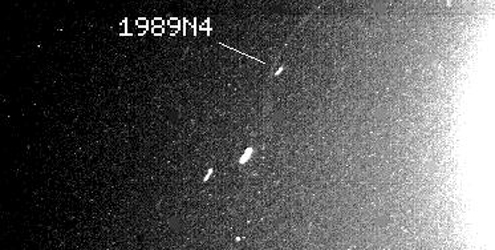Galatea (moon) on:
[Wikipedia]
[Google]
[Amazon]
Galatea , also known as Neptune VI, is the fourth-closest inner moon of
 Galatea was discovered in late July 1989 from the images taken by the ''
Galatea was discovered in late July 1989 from the images taken by the ''
Galatea Profile
b
NASA's Solar System Exploration
(by Scott S. Sheppard) {{DEFAULTSORT:Galatea (Moon) Moons of Neptune Astronomical objects discovered in 1989 Moons with a prograde orbit
Neptune
Neptune is the eighth and farthest known planet from the Sun. It is the List of Solar System objects by size, fourth-largest planet in the Solar System by diameter, the third-most-massive planet, and the densest giant planet. It is 17 t ...
, and fifth-largest moon of Neptune. It is named after Galatea, one of the fifty Nereids
In Greek mythology, the Nereids or Nereides ( ; ; , also Νημερτές) are sea nymphs (female spirits of sea waters), the 50 daughters of the 'Old Man of the Sea' Nereus and the Oceanids, Oceanid Doris (Oceanid), Doris, sisters to their bro ...
of Greek legend, with whom Cyclops
In Greek mythology and later Roman mythology, the Cyclopes ( ; , ''Kýklōpes'', "Circle-eyes" or "Round-eyes"; singular Cyclops ; , ''Kýklōps'') are giant one-eyed creatures. Three groups of Cyclopes can be distinguished. In Hesiod's ''Th ...
Polyphemus was vainly in love.
Discovery
 Galatea was discovered in late July 1989 from the images taken by the ''
Galatea was discovered in late July 1989 from the images taken by the ''Voyager 2
''Voyager 2'' is a space probe launched by NASA on August 20, 1977, as a part of the Voyager program. It was launched on a trajectory towards the gas giants (Jupiter and Saturn) and enabled further encounters with the ice giants (Uranus and ...
'' probe. It was given the temporary designation S/1989 N 4. The discovery was announced (IAUC 4824) on 2 August 1989, and mentions "10 frames taken over 5 days", implying a discovery date of sometime before July 28. The name was given on 16 September 1991.
Physical properties
Galatea is irregularly shaped and shows no sign of any geological modification. It is likely that it is a rubble pile re-accreted from fragments of Neptune's original satellites, which were smashed up by perturbations from Triton soon after that moon's capture into a very eccentric initial orbit. Compositionally, Galatea appears to be similar to other small inner Neptunian satellites, with a deep 3.0 micron feature attributed to water ice or hydrated silicate minerals. It has a 0.08 albedo at 1.4 and 2.0 microns, dropping to 0.04 at 3.0 microns, and increasing to 0.12 at 4.6 microns.Orbit
Galatea's orbit lies below Neptune'ssynchronous orbit
A synchronous orbit is an orbit in which an orbiting body (usually a satellite) has a period equal to the average rotational period of the body being orbited (usually a planet), and in the same direction of rotation as that body.
Simplified meani ...
radius, so it is slowly spiralling inward due to tidal deceleration and may eventually impact the planet or break up into a new planetary ring system upon passing its Roche limit
In celestial mechanics, the Roche limit, also called Roche radius, is the distance from a celestial body within which a second celestial body, held together only by its own force of gravity, will disintegrate because the first body's tidal force ...
due to tidal stretching.
Galatea appears to be a shepherd moon for the Adams ring that is outside its orbit. Resonances
Resonance is a phenomenon that occurs when an object or system is subjected to an external force or vibration whose frequency matches a resonant frequency (or resonance frequency) of the system, defined as a frequency that generates a maximu ...
with Galatea in the ratio 42:43 are also considered the most likely mechanism for confining the unique ring arcs that exist in this ring. Galatea's mass has been estimated based on the radial perturbations it induces on the ring.
Notes
References
External links
Galatea Profile
b
NASA's Solar System Exploration
(by Scott S. Sheppard) {{DEFAULTSORT:Galatea (Moon) Moons of Neptune Astronomical objects discovered in 1989 Moons with a prograde orbit